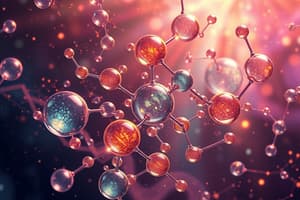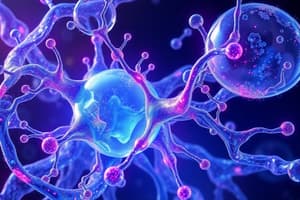Podcast
Questions and Answers
What is the strongest force that holds molecules together?
What is the strongest force that holds molecules together?
- Covalent bond (correct)
- Electrostatic interactions
- Hydrophobic interactions
- Van der Waals forces
What is the primary function of noncovalent forces in biological systems?
What is the primary function of noncovalent forces in biological systems?
- To break down molecules
- To create permanent bonds between molecules
- To contribute to the structure, stability, and functional competence of macromolecules (correct)
- To repel molecules from each other
What type of interaction is responsible for the attraction between positively charged nuclei and electrons of nearby atoms?
What type of interaction is responsible for the attraction between positively charged nuclei and electrons of nearby atoms?
- Electrostatic interactions
- Dispersion forces
- Induced electrical interactions (correct)
- Dipole-dipole interactions
What is the range of decrease in interaction energy for dipole-dipole interactions?
What is the range of decrease in interaction energy for dipole-dipole interactions?
What type of force is responsible for the attraction between all molecules, including those without permanent dipoles?
What type of force is responsible for the attraction between all molecules, including those without permanent dipoles?
What is the distance over which van der Waals attractions operate?
What is the distance over which van der Waals attractions operate?
What is necessary for van der Waals attractions to be effective at physiological temperatures?
What is necessary for van der Waals attractions to be effective at physiological temperatures?
Why must atoms on interacting molecules pack together neatly for van der Waals attractions to be effective?
Why must atoms on interacting molecules pack together neatly for van der Waals attractions to be effective?
What is the equilibrium constant given by?
What is the equilibrium constant given by?
What is the effect of enzymes on the equilibrium position of a reaction?
What is the effect of enzymes on the equilibrium position of a reaction?
What is the purpose of oxidative phosphorylation?
What is the purpose of oxidative phosphorylation?
What is the pH of the blood in healthy individuals?
What is the pH of the blood in healthy individuals?
What is the end product of the oxidation of macromolecules?
What is the end product of the oxidation of macromolecules?
What are the three stages of catabolism?
What are the three stages of catabolism?
What is the purpose of buffering in biological fluids?
What is the purpose of buffering in biological fluids?
What is the pK of the phosphate ion?
What is the pK of the phosphate ion?
What is the role of electron carriers in oxidative phosphorylation?
What is the role of electron carriers in oxidative phosphorylation?
What is the result of oxidation reactions?
What is the result of oxidation reactions?
Why is it crucial to buffer the pH of a solution when working with enzymes and proteins?
Why is it crucial to buffer the pH of a solution when working with enzymes and proteins?
What is the ultimate source of energy for the cell?
What is the ultimate source of energy for the cell?
What is the pH range in which many biological molecules are effective at buffering?
What is the pH range in which many biological molecules are effective at buffering?
What is the name of the ion that helps maintain the pH of extracellular fluid between 7.35 and 7.45?
What is the name of the ion that helps maintain the pH of extracellular fluid between 7.35 and 7.45?
What is the term used to describe a disturbance in the body's acid-base balance?
What is the term used to describe a disturbance in the body's acid-base balance?
What is the purpose of measuring the pH of arterial blood and the CO2 content of venous blood?
What is the purpose of measuring the pH of arterial blood and the CO2 content of venous blood?
What is the pH of a solution considered to be neutral?
What is the pH of a solution considered to be neutral?
What does a pH below 7.0 indicate about a solution?
What does a pH below 7.0 indicate about a solution?
What is the purpose of buffers in the body?
What is the purpose of buffers in the body?
What is the pH of the body?
What is the pH of the body?
What is the result of a solution having a pH of 5.0?
What is the result of a solution having a pH of 5.0?
What is the role of the bicarbonate - carbonic acid system in the body?
What is the role of the bicarbonate - carbonic acid system in the body?
Why is it important to maintain pH levels in the body?
Why is it important to maintain pH levels in the body?
What is the pH scale measured from?
What is the pH scale measured from?
What is the result of combining HCO3- with hydrogen ions?
What is the result of combining HCO3- with hydrogen ions?
What is the pH range for acidosis?
What is the pH range for acidosis?
What is the purpose of measuring pH in biochemistry?
What is the purpose of measuring pH in biochemistry?
What is the normal pH value of blood plasma?
What is the normal pH value of blood plasma?
What is the term for an excess of base in the blood that causes the pH to rise above 7.45?
What is the term for an excess of base in the blood that causes the pH to rise above 7.45?
What is the formula for calculating the anion gap?
What is the formula for calculating the anion gap?
What is the result of combining OH with H2CO3?
What is the result of combining OH with H2CO3?
What is the term for an excess of acid in the blood that causes the pH to fall below 7.35?
What is the term for an excess of acid in the blood that causes the pH to fall below 7.35?
Flashcards are hidden until you start studying
Study Notes
Covalent and Noncovalent Forces
- Covalent bonds are the strongest forces that hold molecules together
- Noncovalent forces, although weaker, contribute significantly to the structure, stability, and functional competence of macromolecules in living organisms
- Examples of noncovalent forces include hydrophobic interactions, electrostatic interactions, and van der Waals forces
Van der Waals Forces
- Result from induced electrical interactions between closely approaching atoms or molecules due to fluctuations in electron clouds
- Include dipole-dipole interactions, dipole-induced dipole interactions, and induced dipole-induced dipole interactions (London dispersion forces)
- Contribute to attractive intermolecular forces between all molecules, including those without permanent dipoles
Energy and Oxidative Phosphorylation
- Energy is made available to cells by breaking down high-energy chemical bonds in food substances (carbohydrates, proteins, and lipids) through enzymatic conversion to their monomer units
- Oxidation of these molecules occurs in small controlled steps to carbon dioxide and water, releasing energy
- Stages of catabolism: extraction of energy from fuels can be divided into three stages
Buffers and pH Regulation
- Buffers resist changes in pH of a solution by acting as acid-base conjugate pairs (e.g., acetic acid and acetate)
- Effective buffering occurs within 1 pH unit of the pK (pK+1)
- Biological fluids, including blood, are buffered to maintain a narrow pH range (pH 6-8)
- Major buffering components in biological fluids include phosphate and carbonate ions, as well as acid-base groups in amino acids, proteins, nucleic acids, and lipids
Acid-Base Disorders and pH Measurement
- pH is a measure of hydrogen ion concentration in body fluids, with a pH range of 0-14 and a neutral pH of 7.0 (water)
- Acidosis occurs when pH falls below 7.35, and alkalosis occurs when pH rises above 7.45
- pH measurement is crucial in biochemistry and medical diagnoses, as it affects the structure and activity of biological macromolecules
Studying That Suits You
Use AI to generate personalized quizzes and flashcards to suit your learning preferences.




